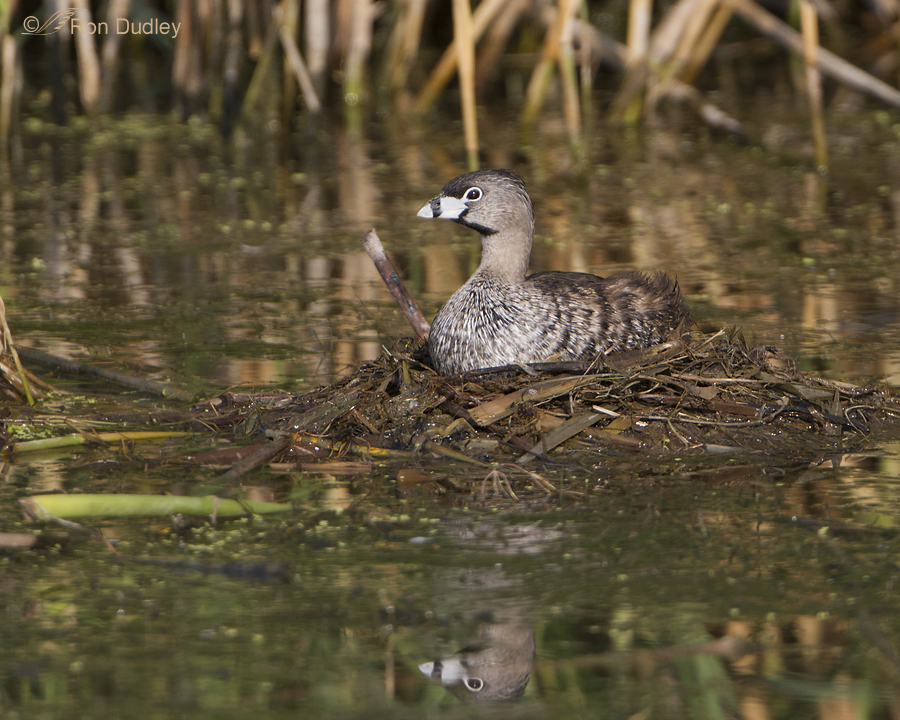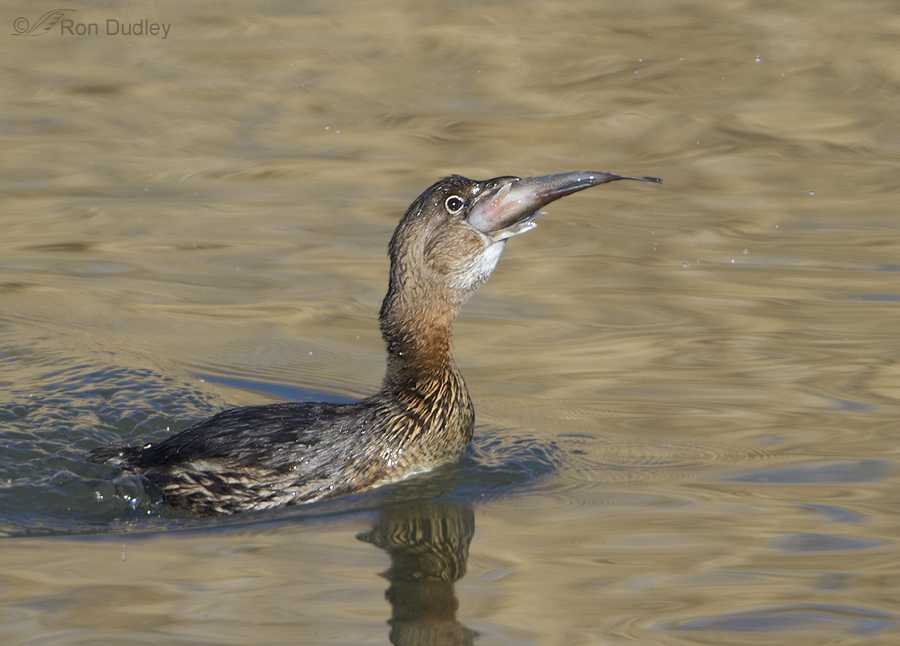Tag: podilymbus podiceps
Pied-billed Grebe On Nest

Yesterday morning I was very surprised to see this active nest so close to the loop road at Bear River Migratory Bird Refuge. Both parents incubate and the sexes are similar so I don’t know if this was the male or the female but the apparent mate of this bird was hanging around in the general vicinity.
A Couple Of Interesting Pied-billed Grebe Behaviors
I love watching and photographing these small grebes because their pugnacious behaviors produce some fascinating interactions. They just may be the most aggressive bird species I’ve ever photographed.
A Pied-billed Grebe Attempts To Dismember A Frog
Pied-billed Grebes are opportunistic feeders, taking large crustaceans (especially crayfish), fish, insects and other invertebrates. They also consume a lot of frogs when they’re available. When the prey is too large to swallow whole (frogs and crayfish especially) they grasp the appendages with their beak and shake it vigorously until the limbs break off. I’ve also seen adults tear off bits of the body trunk of frogs to feed to their chicks. This bird is a juvenile, still learning the finer points of consuming prey. This stage of plumage development is referred to as the “stripe-head stage”, for obvious reasons. Adults lose those stripes. The frog it has captured is probably one of the first amphibians the bird has had to deal with without assistance from a parent and that inexperience seemed obvious as the young bird dealt with the frog. I’ve presented all the photos in this series in the order they were taken. As you can see, the young frog hasn’t yet fully metamorphosed into an adult and retains the tadpole tail. The grebe would repeatedly grasp a limb (it tried all 5 of them several times)… and then shake the frog violently in an apparent attempt to tear the appendage off like it has seen its parents do so many times before. Here it’s working on the left front leg. Other times the bird would grasp the body and shake. Hard! At times the grebe would appear to rest and “think” about its…
A Gluttonous Pied-billed Grebe
Pied-billed Grebes are opportunistic feeders so they’re not very fussy about what they eat, but they do seem particularly fond of crayfish, fish and frogs (including tadpoles). Before consuming crayfish and frogs (both are often too large to swallow whole) they rip them apart in an incredibly rapid shaking frenzy that tears off limbs and pieces before they’re swallowed (something I’ve documented here with a frog). They have very strong jaw muscles and before swallowing fish they repeatedly pinch them with their beak, which kills them by damaging their internal organs. Occasionally, when choosing prey, their eyes are bigger than their stomachs – as you’re about to see. (all images are presented in the order that they occurred) All images presented in this post had the following techs: f/6.3, ISO 500, 500 f/4, 1.4 tc, shutter speed ranged from 1/2000 to 1/1250 Last winter, I noticed this grebe just after it surfaced with a fish. A very large fish, at least relative to the size of the bird who must now swallow it. (I’ve never seen one tear a fish into smaller pieces before eating it). As a side-note, I liked the “extra eye” in the reflection at the bottom of the frame. I thought this image would give the viewer a good sense for the size of the fish – especially its width! But the poor bird didn’t have any time at all to get the meal down before other grebes rushed in to try to steal the fish. The competition at times like this is…
Pied-billed Grebe Showing Off A Little
I’ve always thought of Pied-billed Grebes as sort of the Rodney Dangerfields of the bird world because they just “don’t get no respect”. At least they don’t get as much as I think they deserve from bird photographers. They’re plain little brown birds, very common (in fact they’re the most widely distributed grebe species in North America) and often when they’re seen they’re just sitting calmly on the water so many photographers usually ignore them. But if you spend enough time with them it won’t be long till you see that they’re full of personality and interesting behaviors. They’re pugnacious, aggressive and extremely active in bursts. I enjoy the heck out of them. 1/1600, f/6.3, ISO 500, 500 f/4, 1.4 tc, natural light, not baited, set up or called in While I was watching this bird float effortlessly on the water it began to rouse (ruffle its feathers). Sometimes rousing is a precursor to a wing flap so this time… 1/1600, f/6.3, ISO 500, 500 f/4, 1.4 tc, natural light, not baited, set up or called in I was ready when it happened. When grebes do a wing flap they raise their chubby little bodies out of the water. 1/1600, f/6.3, ISO 500, 500 f/4, 1.4 tc, natural light, not baited, set up or called in This one didn’t last long and here the bird is already beginning to settle back onto the water. 1/1600, f/6.3, ISO 500, 500 f/4, 1.4 tc, natural light, not baited, set up or called in…
Pied-billed Grebe On Nest

Yesterday morning I was very surprised to see this active nest so close to the loop road at Bear River Migratory Bird Refuge. Both parents incubate and the sexes are similar so I don’t know if this was the male or the female but the apparent mate of this bird was hanging around in the general vicinity.
A Couple Of Interesting Pied-billed Grebe Behaviors
I love watching and photographing these small grebes because their pugnacious behaviors produce some fascinating interactions. They just may be the most aggressive bird species I’ve ever photographed.
A Pied-billed Grebe Attempts To Dismember A Frog
Pied-billed Grebes are opportunistic feeders, taking large crustaceans (especially crayfish), fish, insects and other invertebrates. They also consume a lot of frogs when they’re available. When the prey is too large to swallow whole (frogs and crayfish especially) they grasp the appendages with their beak and shake it vigorously until the limbs break off. I’ve also seen adults tear off bits of the body trunk of frogs to feed to their chicks. This bird is a juvenile, still learning the finer points of consuming prey. This stage of plumage development is referred to as the “stripe-head stage”, for obvious reasons. Adults lose those stripes. The frog it has captured is probably one of the first amphibians the bird has had to deal with without assistance from a parent and that inexperience seemed obvious as the young bird dealt with the frog. I’ve presented all the photos in this series in the order they were taken. As you can see, the young frog hasn’t yet fully metamorphosed into an adult and retains the tadpole tail. The grebe would repeatedly grasp a limb (it tried all 5 of them several times)… and then shake the frog violently in an apparent attempt to tear the appendage off like it has seen its parents do so many times before. Here it’s working on the left front leg. Other times the bird would grasp the body and shake. Hard! At times the grebe would appear to rest and “think” about its…
A Gluttonous Pied-billed Grebe
Pied-billed Grebes are opportunistic feeders so they’re not very fussy about what they eat, but they do seem particularly fond of crayfish, fish and frogs (including tadpoles). Before consuming crayfish and frogs (both are often too large to swallow whole) they rip them apart in an incredibly rapid shaking frenzy that tears off limbs and pieces before they’re swallowed (something I’ve documented here with a frog). They have very strong jaw muscles and before swallowing fish they repeatedly pinch them with their beak, which kills them by damaging their internal organs. Occasionally, when choosing prey, their eyes are bigger than their stomachs – as you’re about to see. (all images are presented in the order that they occurred) All images presented in this post had the following techs: f/6.3, ISO 500, 500 f/4, 1.4 tc, shutter speed ranged from 1/2000 to 1/1250 Last winter, I noticed this grebe just after it surfaced with a fish. A very large fish, at least relative to the size of the bird who must now swallow it. (I’ve never seen one tear a fish into smaller pieces before eating it). As a side-note, I liked the “extra eye” in the reflection at the bottom of the frame. I thought this image would give the viewer a good sense for the size of the fish – especially its width! But the poor bird didn’t have any time at all to get the meal down before other grebes rushed in to try to steal the fish. The competition at times like this is…
Pied-billed Grebe Showing Off A Little
I’ve always thought of Pied-billed Grebes as sort of the Rodney Dangerfields of the bird world because they just “don’t get no respect”. At least they don’t get as much as I think they deserve from bird photographers. They’re plain little brown birds, very common (in fact they’re the most widely distributed grebe species in North America) and often when they’re seen they’re just sitting calmly on the water so many photographers usually ignore them. But if you spend enough time with them it won’t be long till you see that they’re full of personality and interesting behaviors. They’re pugnacious, aggressive and extremely active in bursts. I enjoy the heck out of them. 1/1600, f/6.3, ISO 500, 500 f/4, 1.4 tc, natural light, not baited, set up or called in While I was watching this bird float effortlessly on the water it began to rouse (ruffle its feathers). Sometimes rousing is a precursor to a wing flap so this time… 1/1600, f/6.3, ISO 500, 500 f/4, 1.4 tc, natural light, not baited, set up or called in I was ready when it happened. When grebes do a wing flap they raise their chubby little bodies out of the water. 1/1600, f/6.3, ISO 500, 500 f/4, 1.4 tc, natural light, not baited, set up or called in This one didn’t last long and here the bird is already beginning to settle back onto the water. 1/1600, f/6.3, ISO 500, 500 f/4, 1.4 tc, natural light, not baited, set up or called in…


